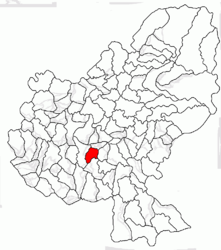Gheorghe Doja, Mureș
Gheorghe Doja (Hungarian: Lukafalva, Hungarian pronunciation: [ˈlukɒfɒlvɒ]) is a commune in Mureș County, Transylvania, Romania composed of five villages:
- Gheorghe Doja / Lukafalva
- Ilieni / Lukailencfalva
- Leordeni / Lőrincfalva
- Satu Nou / Teremiújfalu
- Tirimia / Nagyteremi
Gheorghe Doja Lukafalva | |
|---|---|
.jpg) Reformed church in Gheorghe Doja | |
 Location in Mureș County | |
 Gheorghe Doja Location in Romania | |
| Coordinates: 46°28′N 24°30′E | |
| Country | |
| County | Mureș |
| Government | |
| • Mayor | Tibor Iszlai (UDMR) |
| Area | 37.45 km2 (14.46 sq mi) |
| Population (2011)[1] | 2,982 |
| • Density | 80/km2 (210/sq mi) |
| Time zone | EET/EEST (UTC+2/+3) |
| Vehicle reg. | MS |
History
The locality was mentioned for the first time in 1409 as Lucafalva. During its history, there were several military raids carried out against the village which also sustained a lot from flooding. After the break-up of Austria-Hungary at the end of World War I and the Hungarian–Romanian War of 1918–19, the town became part of the Kingdom of Romania. As a result of the Second Vienna Award it became a part of the Kingdom of Hungary between 1940 and 1945. Since then Gheorghe Doja has been part of Romania; it is named after György Dózsa, who led a peasants' revolt against landed nobility at the beginning of the 16th century.
Demographics
The commune has an absolute Hungarian majority. In 1910, it had a population of 713 Hungarians. According to the 2011 census, Gheorghe Doja has a population of 2,982, of which 72.74% are Hungarians, 20.69% are Romanians, and 5% are Roma.
References
- "Populaţia stabilă pe judeţe, municipii, oraşe şi localităti componenete la RPL_2011" (in Romanian). National Institute of Statistics. Retrieved 4 February 2014.
